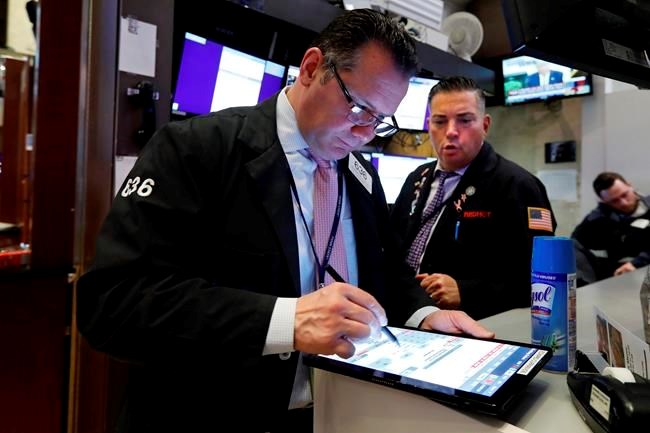WASHINGTON — The Federal Reserve moved Thursday to try to ease disruptions in the financial markets stemming from the coronavirus by announcing that it will sharply increase its purchases of short-term Treasury bonds.
The Fed said it's making available at least $2 trillion in short-term lending as a way to ensure that the Treasury market can function smoothly. It's also broadening its ongoing $60 billion-a-month purchases of Treasurys to include longer-term bonds.
Initially, the Fed's actions led the stock market to sharply pare its deep losses, before share prices fell back down. By mid-afternoon, the Dow Jones Industrial Average was still off more than 8%. Likewise, the announcement caused Treasury yields to fall before they rose back up again.
The reaction in the markets suggested little faith that the Fed's moves would do much to restore the confidence of investors and consumers in the face of travel disruptions, event cancellations and business closures.
Thursday's central bank action, being led by the New York Fed, is intended to keep credit markets functioning and ensure that banks can continue to provide loans to businesses and other borrowers across the economy.
“The New York Fed fired its bazooka,” said Paul Ashworth, an economist at Capital Economics.
The action follows signs of stress in the bond market. On Wednesday when the stock market plunged, bond yields actually rose. Typically, in circumstances like this, the two would move together: Investors would move en masse into the bond market, driving down bond yields as bond prices rose.
The disjointed move in prices likely signals a lack of liquidity in the bond market. That means there are too few buyers or sellers, causing prices to move violently and make prices less easy to pinpoint.
“There are massive concerns out there," said Tom di Galoma with Seaport Global Holdings. "Market-making is under severe pressure. This is beyond the market’s current capabilities.”
In a note to investors, analysts at Bank of America said that the U.S. bond market has “materially deteriorated over recent days” and now “requires a rapid and large near-term policy response from the U.S. treasury or Federal Reserve.”
Earlier in the day, the European Central Bank deployed targeted new stimulus measures to cushion the shock to the economy from the virus outbreak. The ECB's president said, though, that monetary policy couldn't do it alone and called for a "decisive and determined” response from governments.
President Christine Lagarde said the economy was facing a “major shock” and that the central bank measures unveiled Thursday were “almost surgically” targeted at areas where monetary policy could help.
The market for U.S. Treasurys is the foundation of all other financial products on Wall Street. Because investors believe the U.S. government would never default on its debt, the bonds issued by the U.S. government are used to price every other asset. The market for U.S. government debt is enormous — roughly $17.5 trillion, the largest single pools of investment assets in the world.
Individual Treasurys are used to price key price financial products that everyday Americans use. The 10-year bond is the underlying basis for the 30-year fixed-rate mortgage, while the 3-month note is used to price CDs and money market accounts.
More than a decade ago, central banks around the world slashed interest rates and began pumping trillions of dollars into banks to combat a global financial crisis. The coronavirus is presenting them with a very different challenge - at a time when some policymakers have barely caught their breath from the last economic disaster.
The central banks in the U.S., the eurozone, Canada and Britain have all deployed stimulus. The Bank of Japan is
Authorities are putting major economies, businesses and travel on lock down around the world - slamming the prospect for the global economy. But Lagarde underlined Thursday something that seems to be spooking financial markets: Central bank are limited in their capacity to help the economy. She repeatedly pleaded for governments to pitch in by spending more or giving companies and families tax relief.
Europe's top monetary authority didn't cut rates as investors had hoped - a sign that monetary policy is running low on ammunition with rates already very low. The ECB's key policy rate on bank deposits is already at an unprecedented minus 0.6%.
The heart of the matter is that the coronavirus affects economies in ways far different from the bursting debt bubbles that afflicted markets and economies in 2008-9. The virus has hit demand by cancelling activity from manufacturing to trade shows to vacations to basketball games. No amount of cheap credit will reopen those events.
All the central bankers can do its aim their powers at the secondary effects: shaken confidence, plunging stocks, worried consumers and cautious bankers.
And it's an uphill struggle. Even a surprise half-percentage point rate cut by the Federal Reserve only halted the stock selloff for a few hours. The ability to shock and awe is clearly diminished.
Marcel Fratscher, head of the German Institute for Economic Research in Berlin, told the dpa news agency that “unlike during the global financial crisis, the central banks will only be able to help a little in combating the economic damage from the coronavirus.”
___
AP Writer Ken Sweet contributed to this report from New York.
Christopher Rugaber, The Associated Press



